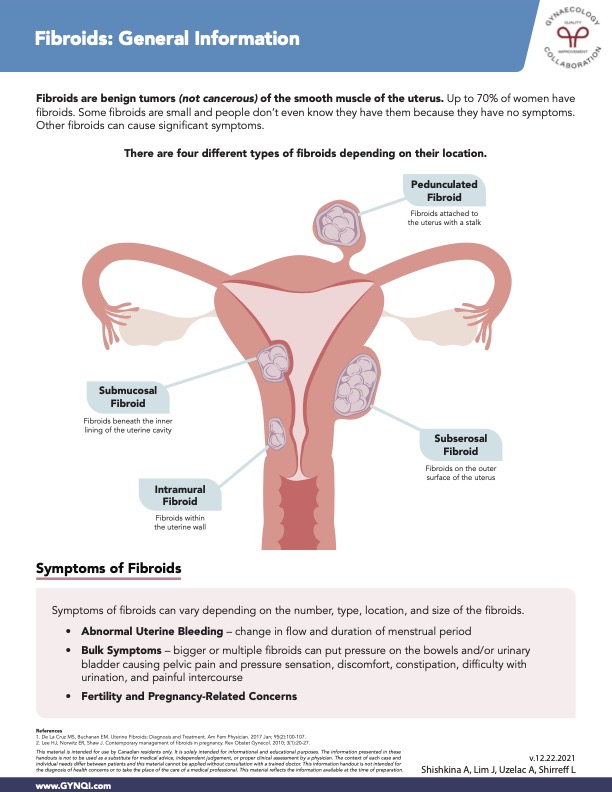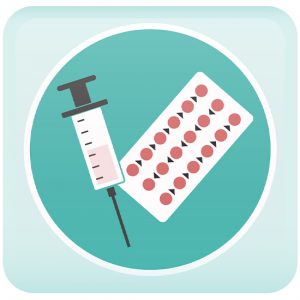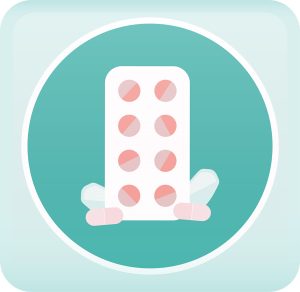
Table of Contents
- Summary
- Introduction
- Types of Fibroids
- Symptoms of Fibroids
- How are Fibroids Treated?
- Should You Consider a Hysterectomy?
Summary:
- Fibroids are benign growths that develop on or inside the uterus in people of childbearing age (typically 16-50). While they are usually non-cancerous, they can sometimes cause debilitating symptoms like pain or heavy bleeding.
- Most fibroids fall into one of four categories that refer to where the growth develops. This shortlist includes pedunculated fibroids, submucosal fibroids, intramural fibroids, and subserosal fibroids.
- Fibroids are sometimes asymptomatic. In other cases, they trigger abnormal menstrual bleeding, severe pain, fertility problems, and issues related to pressure on surrounding organs, like the bladder.
- Treatment options for fibroids include oral medications, hormonal IUDs, uterine artery embolization, and laparoscopic and open abdominal surgeries. A small number of people may need or opt for a hysterectomy instead.
Fibroids are benign tumors (not cancerous) of the smooth muscle of the uterus. Some fibroids are small and people don’t even know they have them because they have no symptoms, while others cause debilitating pain or heavy bleeding.
Up to 80% of all women will have at least one fibroid during their childbearing years, and developing one fibroid makes you more likely to develop more in the future. That’s why it’s so important to get evaluated and treated as soon as you suspect a problem.
Types of Fibroids
Fibroids fall into four main categories. Each refers to where the growth develops and grows in relation to the uterus itself:
- Pedunculated Fibroid: Fibroids attached to the uterus by a stalk.
- Submucosal Fibroid: Fibroids beneath the inner lining of the uterine cavity.
- Intramural Fibroid: Fibroids within the uterine wall itself.
- Subserosal Fibroid: Fibroids on the outer surface of the uterus.
Symptoms of Fibroids
Symptoms of fibroids can vary depending on the number, type, location, and size. For some people, they are entirely asymptomatic and are first noticed incidentally during an examination or unrelated imaging. For others, fibroids can cause:
- Abnormal Uterine Bleeding. This may occur during your period, or you might start to experience breakthrough bleeding and spotting.
- Heavy Periods. Periods may become extremely heavy with clots ranging from the size of a quarter to as large as a palm.
- Bulk Symptoms. Some people report a constant sensation of fullness, pressure in the abdomen, or difficulties with urination and constipation.
- Fertility and Pregnancy-Related Concerns: Fibroids that are large or positioned in certain areas can affect fertility. In rare cases, they may also jeopardize a pregnancy or lead to early miscarriage.
It’s important to note that no two people experience fibroids in exactly the same way. Your symptoms may be vague or feel disconnected (e.g., fatigue, back pain), or they may be severe enough to seriously interfere with daily life. Getting treatment can help you get your life back and get relief.
How are Fibroids Treated?
Fibroids that are asymptomatic and don’t cause debilitating symptoms may need no treatment at all. However, all growths should be monitored for changes, at a minimum, especially during the first 6 to 12 months after diagnosis.
Your doctor may suggest these fibroid treatments:
- Watchful Waiting: For fibroids that do not cause symptoms, a doctor may schedule you for imaging every three, six, nine, or 12 months. You may not require any immediate treatment beyond this if your fibroids are few in number or small.
- Medications: Oral hormones, birth control pills (e.g., Jencycla), and hormonal IUDs can offer effective relief from symptoms like heavy bleeding. Your doctor may also recommend trying gonadotropin-releasing hormone (GnRH) agonists, which will also shrink the fibroids themselves.
- MRI-Guided Focused Ultrasound Surgery (FUS): FUS can destroy small fibroids without the need for incisions. However, it isn’t ideal for every patient, as it is only effective for small fibroids and is generally done as an outpatient procedure where you remain awake. Your doctor may recommend twilight sedation or general anesthesia if you are anxious or nervous about pain.
- Uterine Artery Embolization (UAE) involves threading a thin catheter through a small incision, usually in the groin or inner wrist. Your surgeon guides the catheter through your cardiovascular system and into the arteries that supply your fibroids with blood. They inject tiny particles into the area, causing the fibroid to shrink or die off.
- Laparoscopic Myomectomy: Sometimes called robotic myomectomy, this is a minimally invasive surgical procedure to remove fibroids via a series of small incisions in the abdomen. It spares the uterus itself, unlike hysterectomy, which may be the right option for women who still want to bear children.
- Myomectomy: Myomectomy can also be done as an open abdominal surgery. In fact, this may be the only option for fibroids that are extremely large or connected to surrounding tissues by adhesions (scar tissue).
- Hysterectomy: Typically considered a last resort, hysterectomy is a surgical procedure that involves removing the entire uterus and sometimes, the ovaries and cervix. This procedure isn’t suitable for women who still want to become pregnant.
No one treatment is right for every patient or every situation. Your doctor will work closely with you to find the best option for you while also doing their best to mitigate potential factors like complications, recovery time, and pain. You always have the option to decline surgery or request a different approach, regardless of what your doctor suggests.
Should You Consider a Hysterectomy?
Deciding whether to consider a hysterectomy for fibroids depends on several unique factors, including the location of your fibroids, your age, and the number of fibroids present. Generally speaking, a hysterectomy is significantly more invasive than other treatment options, which raises your risk for complications like infection and post-operative or chronic pain.
Most doctors and surgeons will only recommend hysterectomy in situations where there is no other option or when other treatments don’t work. However, some patients prefer the idea of a hysterectomy because it can provide permanent relief from fibroid symptoms, especially if they’re done having children or don’t want any in the first place.
Whether you feel a hysterectomy is right for you or it’s a procedure you absolutely do not want, don’t be afraid to let your doctor know. They may or may not agree with you, but any decisions should be made with your input—and your consent—before you move forward.
Fibroids Don’t Have to Hold You Back
If you’re struggling with fibroids and the symptoms they cause, it’s important to know that you don’t have to suffer in silence. Medications like progestins, hormonal IUDs, and GnrH agonists can effectively treat symptoms like pain, heavy bleeding, and fertility problems, often without the need for extensive surgery.
Even if you do need surgery, new procedures like laparoscopy and robotic surgery have made it easier to remove fibroids with less post-operative pain and recovery time. Ask your doctor if one of these options can help restore your quality of life.



